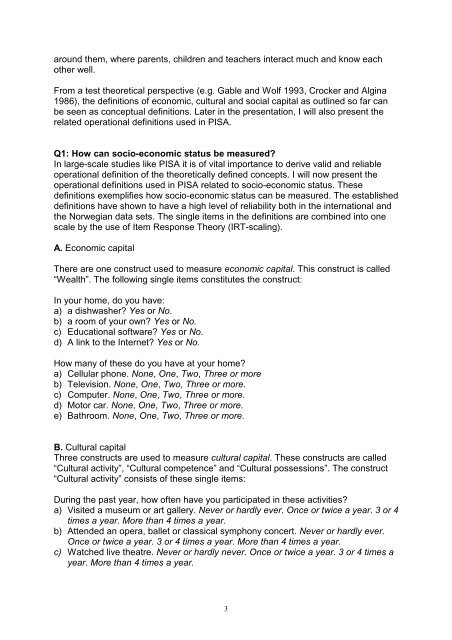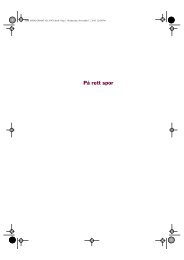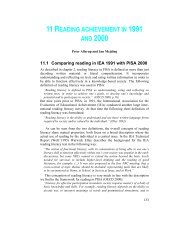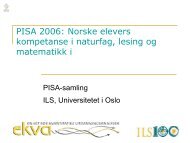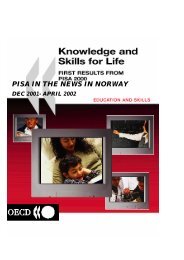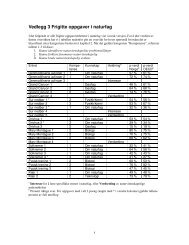of the last half-century have attempted to make education <strong>and</strong> training systemsfunction so that student outcomes (such as school <strong>achievement</strong>) are not too stronglyrelated to their <strong>socio</strong>-<strong>economic</strong> background <strong>and</strong> other ascribed characteristics of thestudent, such as gender, ethnic group <strong>and</strong> urban/rural location. One of the threedomains being assessed in PISA, is scientific literacy. Scientific literacy is defined as“the capacity to use scientific knowledge, to identify questions <strong>and</strong> to draw evidencebased conclusions in order to underst<strong>and</strong> <strong>and</strong> help make decisions about the naturalworld <strong>and</strong> the changes made to it through human activity” (OECD 2000). Threedimensions of scientific literacy are identified; scientific processes or skills, concepts<strong>and</strong> content, <strong>and</strong> contexts. PISA is well placed to provide evidence that unpack therelationship between social background <strong>and</strong> performance. It will be possible toexplore which aspects of students’ background have the greatest impact on student<strong>achievement</strong>; their levels of reading, mathematical, <strong>and</strong> scientific literacy. My focushere is on scientific literacy.A popular belief about a mechanism that generates differences in student<strong>achievement</strong> is that of differential access to financial resources. The implicitassumption is that schooling has financial costs, <strong>and</strong> well-off parents are in a betterposition to overcome these costs. PISA cannot directly assess the effects of parentalincome since reliable information cannot be obtained from student questionnaires.However, PISA can address the issues at stake through proxy measurement. ThePISA student questionnaire includes items on possessions of goods at home, whichis generally viewed as an indicator of household wealth. Furthermore, PISAapproximates income by separating occupational <strong>status</strong> into an earning relatedcomponent <strong>and</strong> an education related component, as has been suggested <strong>and</strong> triedby Hauser <strong>and</strong> Warren (1997). While the previous research suggests that financialinequality among parents is not among the primary sources of differences in studentperformance in European welfare states, the PISA data can be used to address thishypothesis empirically.The second type of resources examined are resources referred to as “cultural”. In linewith Bourdieu’s (1973, 1984) cultural reproduction theory, there is evidence that thereare strong direct effects of parental cultural backgrounds on student <strong>achievement</strong> inmany countries. In its most modest form, cultural reproduction theory is close tohuman capital (Becker 1965) interpretations of the educational selection process <strong>and</strong>suggests that parents who are themselves highly educated <strong>and</strong> knowledgeable aboutacademic requirements are better able to help their children through school. Otherversions of cultural reproduction theory maintain that cultural reproductioncompensates for the disappearances of <strong>economic</strong> forms of social <strong>status</strong>.The third type of resource is “social capital” (Coleman 1988) which refers to theresources provided through social ties that can be mobilised to improve a socialoutcome, such as educational performance. The more parents have access to suchresources via their social network etc., the more successful the educational career oftheir children may be. In student performance studies, social capital often has beenunderstood as the specific ties that exist between parents <strong>and</strong> the school, betweenparents <strong>and</strong> other parents, <strong>and</strong> between parents <strong>and</strong> the teachers. More broadlytaken, any kind of parental involvement with school can be included in such adefinition. The traditional social capital hypothesis, proposed by Coleman, holds thatchildren do better in schools that have a more closely knit network (community)2
around them, where parents, children <strong>and</strong> teachers interact much <strong>and</strong> know eachother well.From a test theoretical perspective (e.g. Gable <strong>and</strong> Wolf 1993, Crocker <strong>and</strong> Algina1986), the definitions of <strong>economic</strong>, cultural <strong>and</strong> social capital as outlined so far canbe seen as conceptual definitions. Later in the presentation, I will also present therelated operational definitions used in PISA.Q1: How can <strong>socio</strong>-<strong>economic</strong> <strong>status</strong> be measured?In large-scale studies like PISA it is of vital importance to derive valid <strong>and</strong> reliableoperational definition of the theoretically defined concepts. I will now present theoperational definitions used in PISA related to <strong>socio</strong>-<strong>economic</strong> <strong>status</strong>. Thesedefinitions exemplifies how <strong>socio</strong>-<strong>economic</strong> <strong>status</strong> can be measured. The establisheddefinitions have shown to have a high level of reliability both in the international <strong>and</strong>the Norwegian data sets. The single items in the definitions are combined into onescale by the use of Item Response Theory (IRT-scaling).A. Economic capitalThere are one construct used to measure <strong>economic</strong> capital. This construct is called“Wealth”. The following single items constitutes the construct:In your home, do you have:a) a dishwasher? Yes or No.b) a room of your own? Yes or No.c) Educational software? Yes or No.d) A link to the Internet? Yes or No.How many of these do you have at your home?a) Cellular phone. None, One, Two, Three or moreb) Television. None, One, Two, Three or more.c) Computer. None, One, Two, Three or more.d) Motor car. None, One, Two, Three or more.e) Bathroom. None, One, Two, Three or more.B. Cultural capitalThree constructs are used to measure cultural capital. These constructs are called“Cultural activity”, “Cultural competence” <strong>and</strong> “Cultural possessions”. The construct“Cultural activity” consists of these single items:During the past year, how often have you participated in these activities?a) Visited a museum or art gallery. Never or hardly ever. Once or twice a year. 3 or 4times a year. More than 4 times a year.b) Attended an opera, ballet or classical symphony concert. Never or hardly ever.Once or twice a year. 3 or 4 times a year. More than 4 times a year.c) Watched live theatre. Never or hardly never. Once or twice a year. 3 or 4 times ayear. More than 4 times a year.3


